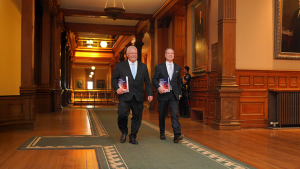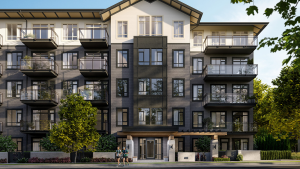It was late, too small, over budget, built on quicksand, and opened up the same year the Titanic went down.
EDMONTON
It was late, too small, over budget, built on quicksand, and opened up the same year the Titanic went down.
The builders also forgot to put a lock on the front door.
Nevertheless, the Alberta legislature has endured for 100 years, its sandstone and granite face and signature terra cotta dome are the undisputed historical and architectural jewel of the province.
It recently began its second century of service with festivities that included a speech by Premier Alison Redford and a re-creation of the Sept. 3, 1912, ceremony that officially opened its doors.
With its grand columns done in the neoclassical style – suggesting the glory of ancient Greece – the legislature has become not only the symbol of democracy in Alberta, but also the focal point of public dissent.
And in some cases, home to very personal tragedy.
For Agriculture Minister Verlyn Olson, it’s literally the structure his family helped build.
His maternal grandfather, Lind Olson, came off the boat from Norway in 1907 looking for a fresh start, heading west to help build the legislature, on the banks overlooking the North Saskatchewan River on the fringe of Edmonton’s downtown.
“I can picture him being a guy who spoke very little English, who did a lot of bull work, carrying stuff,’’ said Olson.
“He probably had some carpentry skills, but as far as I know he wasn’t a craftsman or anything.’’
Granddad, he said, stayed in Alberta to marry and farm around Sedgewick.
More than a century ago, then-lead architect Allan Merrick Jeffers was just trying to get it off the drawing board.
He began planning it soon after Alberta officially became a province in 1905, said Philip Massolin, a historian and the manager of research services for the legislative assembly.
Jeffers, said Massolin, favoured the Beaux-Arts style of legislatures, like the ones in Minnesota and Wisconsin.
He drew the Alberta building to match.
No sooner were the foundations in, when they began to sink in quicksand.
The foundations had to be reinforced, but eventually work continued and the building slowly took shape, granite and marble around a massive steel frame.
“They got the value for money,’’ said Massolin, noting the terra cotta tiles on dome have not shifted, indicating the foundation is still holding.
The budget was $1.25 million.
It came in at $2.4 million, due to the extra costs of hauling in marble and sandstone from Ohio and Calgary.
It was supposed to be done by 1912.
But some of the terra cotta tiles weren’t completed until 1913, months after the official opening.
When it was done, there soon wasn’t room for everybody.
“It was built too small,’’ said Massolin.
“They discovered in 1914 they didn’t have enough room to house all the civil servants in the building and they had to expand elsewhere.’’
It also didn’t have enough security.
The official opening was to feature then governor general, the Duke of Connaught, twisting a ceremonial key in the lock on the massive front doors.
Instead, the duke pretended to put the key in while, on cue, someone inside opened it from within.
It’s been home to four governments and 13 premiers.
It has made history and been witness to history.
In 2000, the building itself was attacked.
Hundreds of demonstrators, protesting a health care bill they said would broaden privatized care, smashed windows, vandalized a door, roughed up a security guard, and slashed a police van’s tires.
Weeks later, when the bill itself was passed by then-premier Ralph Klein’s government, protesters in the public gallery got into bloody fights with security guards.
The protesters threw shredded bits of the bill onto Tory members below shouting “One, two, three, four, Ralph Klein’s a corporate whore!’’
The building has also witnessed the bloody ends to private disputes.
In 1988, Robert Crawford, a father of four distraught over the breakup of his marriage, walked into the legislature as the day began with a rifle in his hand and suicide on his mind.
The 32-year-old wasn’t looking to kill, only be killed.
His gun had a mix of blanks and real bullets.
As he came up the stairs to the front entrance officers ordered him to drop his weapon.
Shots were exchanged and Crawford was drilled in the gut, severing his spine and leaving him a paraplegic.
He later chided the guards for not doing him in.
“I was counting on your guys’ marksmanship to be a little better,’’ he said.
The memory of that day lives on.
There is a bullet hole in the brass door of the elevator near the front desk.
A decade earlier, in the fall of 1977, 38-year-old Guenter Hummel, dressed in a green suit, strode into the legislature, his rifle barely hidden in a garment bag, and into the office of Culture Minister Horst Schmid.
He entered the office, shot his 21-year-old ex-girlfriend Victoria Breitkreusz dead, pointed the rifle at his own heart and pulled the trigger.
The two bodies were wheeled out, a slight figure under a grey blanket and a larger figure under a red one.
It was the first fatal shooting in a political assembly in Canada.
For the centennial celebration, visitors on Sunday will tour a legislature built in the shape of the cross with the front door facing north to the downtown officer towers, and the three-storey legislature assembly toward the back, closer to the river.
The rectangular shaped wings rise east and west, containing the offices of the cabinet ministers, premier, and staff.
The focal point is the rotunda and its circular marble fountain.
Visitors walking up floor by floor can see portraits of premiers past – including the famous Peter Lougheed work with five fingers and a thumb on his right hand – before entering the high-ceilinged assembly chamber lit by more than 600 bulbs.
On the fifth floor, a tiny circle on the floor marks the Magic Spot.
It’s where the sound of the fountain rising in the rotunda below sweeps up the grand staircase, swirls around the inside of the dome before spilling down the other side.
Stand on the Magic Spot and it sounds like the water from below is hitting you from above.
For the romantic, it’s the best spot to contemplate the beauty of an august structure.
For the cynical, it’s the perfect symbol for a place where – for 100 years – down has too often been up.
News from © Canadian Press Enterprises Inc., 2012










Recent Comments
comments for this post are closed